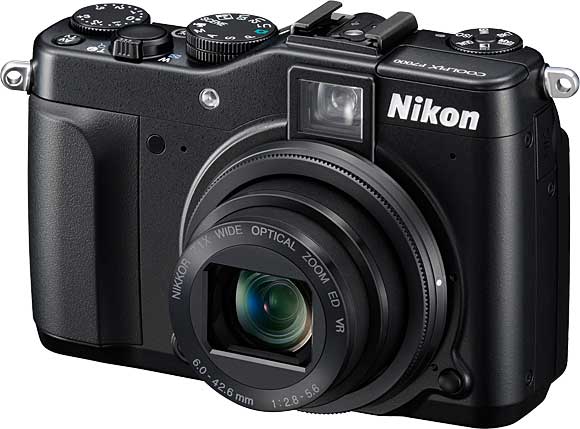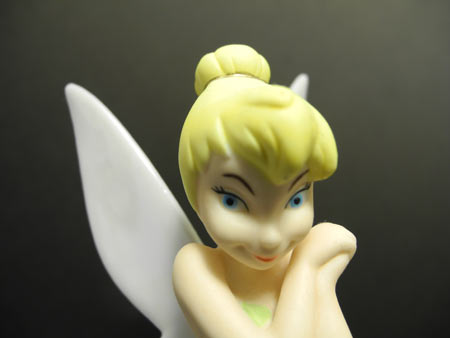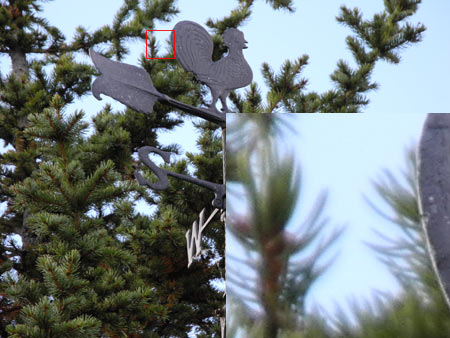Review Date: November 7, 2010
Category: Serious Amateur
IMAGE QUALITY
The Nikon Coolpix P7000 is a digital camera targeted to serious and advanced photographers. It has 10.1 megapixel resolution on a 1/1.7-in. CCD image sensor, and a 6-42.6mm (28-200mm, Equiv.135) 7.1x wide-angle optical Zoom-Nikkor lens, with a maximum aperture of F2.8(W)-F5.6(T), and minimum aperture of F8.0.
We find the overall image quality of the Nikon P7000 to be very good at ISO 100 to ISO 200 (and even ISO 400) with low noise and good detail.
| 7.1x Optical Zoom | |
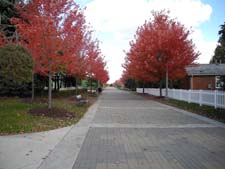 |
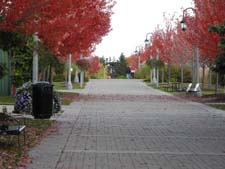 |
| Wide-angle 6mm (28mm, 35mm equivalent) |
Telephoto 42.6mm (200mm, 35mm equivalent) |
The Nikon P7000 has a 7.1x optical Zoom-Nikkor ED VR lens. In the above pictures, we show the coverage for 28mm and 200mm. It takes about 2 sec. to zoom from wide-angle to telephoto (I counted 19 steps).
Besides Auto and easy-to-use Scene Modes, the Nikon P7000 also has full exposure flexibility: Programmed Auto with flexible program (i.e., Program Shift), Aperture-Priority, Shutter-Priority and full Manual modes. Besides AEB (Auto Exposure Bracketing), you can also set the camera to bracket the ISO.
Program Shift (or, Flexible Program, as Nikon refers to it) works in conjunction with Programmed Auto mode (just rotate the Command Dial) and allows you to shift the aperture/shutter speed combinations in tandem while still keeping the correct exposure.
At the wide-angle end, you can select an aperture from f/2.8 to f/8.0; at max telephoto, an aperture from f/5.6 to f/8.0. Unlike some digital cameras that have only electronic apertures, the Nikon P7000 has a real 6-blade iris diaphragm and you can actually hear it close and open when you trip the shutter.
Advanced photographers will welcome the following features: Live Histogram (at last!), Exposure Bracketing, ISO bracketing, Manual White Balance, AF Area mode and corresponding Spot AF Area metering.
Macro can be as close as 3 cm (1.2 in.). The AF frame turns green to indicate successful focus; a blinking red frame indicates focus has not successfully locked.
In low-light, the AF Illuminator automatically kicks in if you have turned it ON [Menu – Set up- AF assist – Auto].
The Nikon P7000 provides AF Area that allows you to select from 99 areas [RIGHT on the Rotary Multi Selector – Manual], though a large swatch of the screen border is not covered.
There are four metering modes: Matrix (Multi-Pattern), Center-weighted, Spot and Spot AF area.
| Auto White Balance Indoors | |
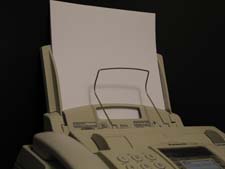 |
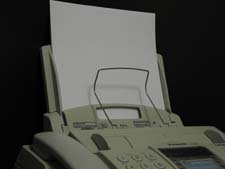 |
| AWB | Custom WB |
As the above two pictures show, the Auto White Balance (AWB) is not quite accurate indoors under artificial lighting (I have two energy-saving fluorescent light bulbs on the ceiling). The Nikon P7000 allows WB to be easily set manually and you can measure and save up to 3 settings (PRE1, PRE2 and PRE3) and this brings out the real colors. AWB works very well in natural light.
[Quick Menu Dial – WB – select PRE1, PRE2 or PRE3 – DOWN to Measure – if necessary, DOWN again to fine tune – place a sheet of white paper in fornt of the camera – OK]| ISO Comparisons | |
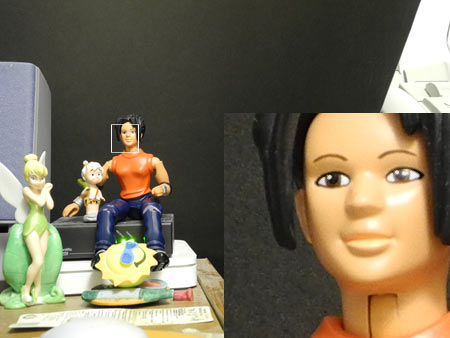 |
|
| ISO 100 | |
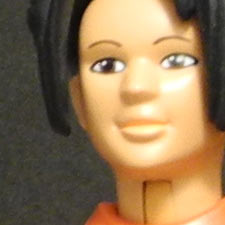 |
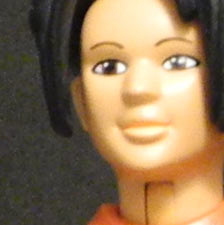 |
| ISO 200 | ISO 400 |
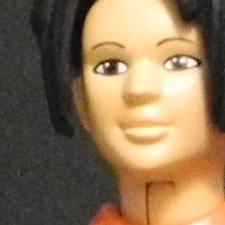 |
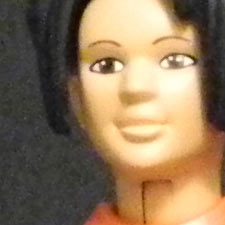 |
| ISO 800 | ISO 1600 |
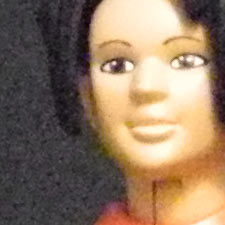 |
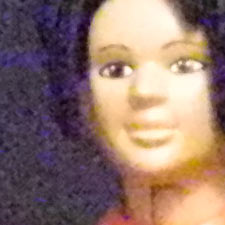 |
| ISO 3200 | ISO 6400 |
The Nikon P7000 has 7 ISO settings going from ISO 100 to ISO 3200, and extendable to ISO 6400 (HI 1). Low Noise Night Mode extends this further to ISO 12800. The 100% crops above (area delimited by the white square) demonstrate the noise at ISO 100 to 6400. At ISO 100 and 200, noise is under control. Noise starts to be slightly visible at ISO 400 but is still very acceptable. Noise (with detail loss) is quite visible at higher ISOs.
At first, we had a frustrating time trying to achieve focus in our low-light test but it turns out that the minimum focusing distance of the P7000 (which is a long 2 – 3 ft. camera to subject distance) goes beyond the reach of our small set. After we had backed up far more than we would have liked, we were then able to take the ISO test shots above.
TIP: If your camera is not locking focus when you think it should easily enough, verify your camera to subject distance (W: 1 ft. 8 in. – T: 2 ft. 8 in.). If you are real close, switch to Macro.
TIP: For best AF performance, use the center AF Frame which seems to lock focus much faster than if you use the AF Frame off-center.
CA is under control in most everyday shots but is slightly present in some high contrast shots. The area delimited by the red square at top left, and reproduced at 100% crop at bottom right, shows very slight purple fringing.
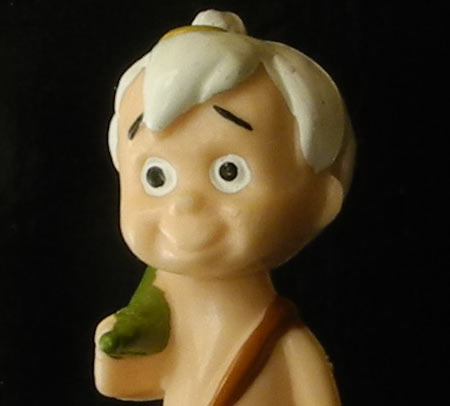
Long Exposure - 28mm (equiv.), Manual, Spot AF, 60 sec., F8, ISO 100, Custom WB, Self-timer (2 sec.), Tripod Used
The LCD screen of the P7000 gains up very well in low light, easily one of the best we’ve seen so far. The Nikon P7000 allows the use of a long shutter speed of up to 60 sec. in Manual shooting mode, therefore allowing very nice night landscape photography. Generally, with image sensors, noise becomes more prominent the longer the shutter is left open. If you turn Long Term Noise Reduction ON [Menu – Shooting Menu – Long exposure NR – On], you’ll notice a longer processing time (approx. twice as long) before the next picture can be taken.
To test this noise reduction algorithm, we take a low-light indoors shot. I experiment a bit to obtain the optimum exposure, eventually settling on 60 sec. at F8. Even at this long shutter speed, the Nikon P7000’s noise reduction seems to be working great, producing a nice smooth blurring effect of the background.
The P7000 has 2 Auto ISO settings: Auto ISO 200 and Auto ISO 400. Set it in Quick Menu – A 200, A400. Overall, very good image quality and noise handling at the ISO 100 and 200, and even ISO 400.
View the Nikon P7000 Photo Gallery [In the Photo Gallery, click on the picture of the camera to return here.]
Note: Some of the sample pictures were taken at the Normal (instead of Fine) image size setting. You’ll notice the small fize sizes.
Next: Nikon P7000 Handling & Feel


